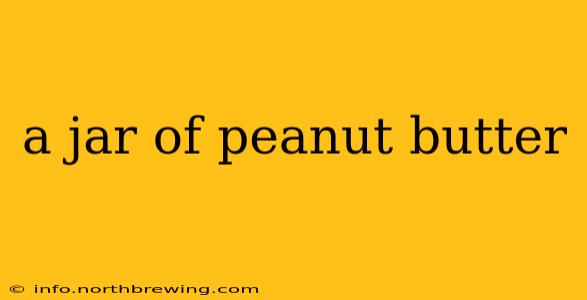A Jar of Peanut Butter: More Than Just a Spread
A seemingly simple jar of peanut butter holds a world of culinary possibilities and fascinating history. From its humble beginnings as a health food to its current status as a pantry staple, peanut butter's journey is as rich and creamy as the product itself. This post will delve into the details of this beloved spread, answering common questions and exploring its multifaceted nature.
What are the different types of peanut butter?
Peanut butter comes in a surprising variety of forms, each catering to different tastes and preferences. The most basic distinction lies in the presence (or absence) of added ingredients. Smooth peanut butter is, as the name suggests, completely smooth and creamy. Crunchy peanut butter contains pieces of peanuts for added texture. Beyond this, you'll find variations based on added ingredients like:
- Natural peanut butter: Often made with only peanuts and possibly salt, natural peanut butter avoids added sugar, preservatives, and hydrogenated oils. It tends to separate, requiring stirring before use.
- Reduced-fat peanut butter: These versions aim to lower the fat content, often resulting in a slightly less rich flavor and texture.
- Sweetened peanut butter: Many brands add sugar for enhanced sweetness, although this can significantly increase the sugar content.
The best type of peanut butter for you depends entirely on your personal preference. Experiment to discover your ideal texture and sweetness level.
How is peanut butter made?
The process of making peanut butter is surprisingly straightforward. Peanuts are first cleaned and roasted to enhance their flavor and reduce moisture content. Then, they are ground using powerful machinery, which breaks down the peanuts into a smooth paste. Depending on the desired type, additional ingredients like salt, sugar, or oil may be added during or after grinding. Finally, the peanut butter is packaged and ready to be enjoyed.
What are the health benefits of peanut butter?
Peanut butter is a nutritional powerhouse, offering several health benefits when consumed in moderation. It’s a good source of:
- Protein: Essential for building and repairing tissues.
- Healthy Fats: Provides monounsaturated and polyunsaturated fats, beneficial for heart health.
- Fiber: Aids digestion and promotes satiety.
- Vitamins and Minerals: Contains vitamins like vitamin E and minerals like magnesium and potassium.
However, it's crucial to remember that peanut butter is also high in calories and fat, so mindful consumption is key to reaping its benefits without negatively impacting your overall health.
Is peanut butter good for weight loss?
Peanut butter's high calorie and fat content can make it seem counterintuitive for weight loss. However, its high protein and fiber content can contribute to feelings of fullness, potentially reducing overall calorie intake. The key is moderation. Incorporating a small serving of peanut butter as part of a balanced diet can be a beneficial addition to a weight-loss plan.
What are some creative ways to use peanut butter?
Peanut butter's versatility extends far beyond simply spreading it on bread. It can be used in:
- Smoothies: Add a spoonful for creaminess and protein.
- Baked goods: Use it as an ingredient in cookies, brownies, or even cakes.
- Sauces: Combine it with soy sauce, honey, and chili garlic sauce for a delicious Asian-inspired sauce.
- Dips: Mix it with applesauce or honey for a healthy and flavorful dip for fruits and vegetables.
The possibilities are truly endless! Let your creativity guide you to discover new and exciting ways to enjoy this beloved spread.
This exploration of the humble jar of peanut butter demonstrates that there's far more to it than meets the eye. Its nutritional value, versatility, and rich history make it a deserving star in the culinary world.
